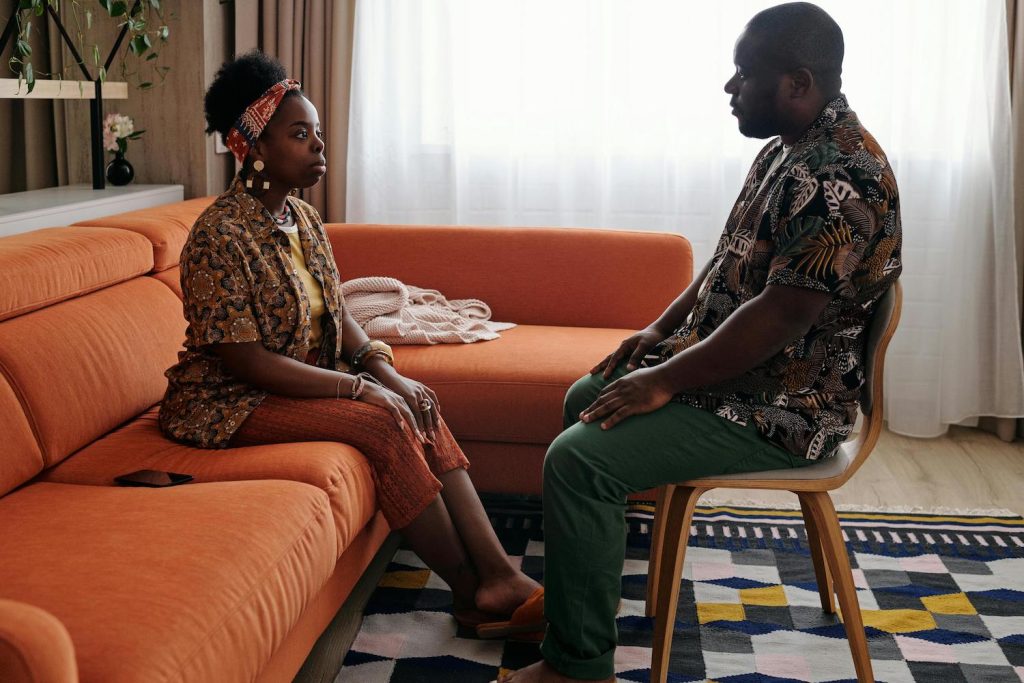21 Couples Communication Exercises to Strengthen Your Relationship
Communication plays a crucial role in any relationship, and it is especially important for couples. Being able to effectively communicate with your partner can strengthen your bond and help resolve conflicts. However, communication does not always come easy, and sometimes, we need to put in the effort to improve our skills. That’s why we’ve put together a list of 21 communication exercises for couples to help you and your partner improve your communication.

Communication plays a crucial role in any relationship, and it is especially important for couples. Being able to effectively communicate with your partner can strengthen your bond and help resolve conflicts. However, communication does not always come easy, and sometimes, we need to put in the effort to improve our skills. That’s why we’ve put together a list of 21 communication exercises for couples to help you and your partner improve your communication.
Learning how to communicate effectively takes time and practice. These exercises are designed to help you and your partner develop active listening skills, express yourselves clearly, and work together as a team. Remember that communication is a two-way street, so make sure both of you participate with an open mind and willingness to learn.
From active listening techniques to conflict resolution strategies, each exercise is thoughtfully crafted to facilitate meaningful conversations and foster a deeper understanding of each other’s perspectives. These exercises are not just for couples who are facing communication issues but also for those looking to strengthen their connection and build a stronger relationship.
Some of the exercises might feel uncomfortable or challenging at first, but that’s part of the learning process. It is important to be patient and understanding with each other as you work through these communication exercises for couples. Remember that the goal is to improve your communication and connection, not to win or prove a point.
So, let’s dive into the 21 communication exercises for couples.
21 communication exercises for couples
Exercise 1: Active listening
Active listening is an essential part of effective communication. Often in a relationship one or both partners can talk over each other or not truly listen to what the other is saying. This exercise involves taking turns speaking and listening to your partner without interrupting them.
In this exercise, one partner will share a story or thought while the other actively listens without interrupting. Set a timer for 3-5 minutes and then switch roles. This exercise helps you practice your active listening skills while also giving both partners the opportunity to feel heard and understood. You should respond to what your partner says after they have finished speaking. This will also show you listened and understood what they said.

Exercise 2: Asking open-ended questions
Open-ended questions are a great way to encourage meaningful conversations. These types of questions cannot be answered with a simple yes or no and instead require more thought and reflection. In this couples communication exercise, take turns asking each other open-ended questions and answering them. This can help you learn more about each other and also practice being curious and engaged in conversation. We have plenty of resources to help you, including 100 intimacy questions for couples.
Exercise 3: Use”I” statements
Using “I” statements instead of accusatory or blaming language can greatly improve communication in a relationship. This is a popular communication exercise used in couples therapy and can be practiced at home as well. The goal is to express your thoughts and feelings without placing blame on your partner.
For example, instead of saying, “You always forget to take out the trash,” try saying, “I feel overwhelmed when the trash isn’t taken out because it creates more work for me.” This helps avoid defensive reactions and allows for a more productive conversation.
Exercise 4: Mirroring exercise
Mirroring is a technique that can be used when couples are having trouble communicating and understanding each other’s perspectives. If you feel like your partner is not understanding what you are trying to say, try mirroring. This involves repeating back what your partner has said using your own words to show that you understand. You take turns to express your thoughts and feelings, and the other partner mirrors back what they heard.
So, if your partner says, “I feel like you don’t appreciate all the work I do around the house,” you can mirror back by saying, “What I hear is that you feel unappreciated for the effort you put into keeping our home clean and organized.” The speaker then confirms if the mirroring is accurate or clarifies any misunderstandings. This exercise can help improve understanding and reduce miscommunication.
Exercise 5: Practice nonverbal communication
Communication isn’t always about what we say but also how we say it. Nonverbal cues like facial expressions and body language can greatly impact the effectiveness of our communication. In this couples communication exercise, take turns conveying different emotions through your body language and expressions and have your partner interpret them. This can help you become more aware of your nonverbal cues and how they may be perceived by your partner.
Exercise 6: Reflect on conversations
After a conversation, it’s important to reflect on what was said and how it made you feel. In this couples communication exercise, each partner should take a few minutes to write down their thoughts and feelings about the conversation they just had. This can help identify any areas of miscommunication or misunderstandings that may have occurred. It’s also a great way to track progress in your communication skills. Share your reflections with each other and discuss ways to improve for future conversations.
Exercise 7: Purposeful pausing
In your day-to-day conversations, introduce a pause to collect your thoughts before responding. This helps avoid knee-jerk reactions and delivers more thoughtful, less reactive responses. It also allows for a brief moment of silence, which can be calming and help de-escalate any tension or conflict. The purposeful pause is a great exercise to practice in any type of communication, whether it’s with your partner or in other relationships.
Exercise 8: 40-20-40
The 40-20-40 exercise is centered around constructive conflict resolution and compassion. During this exercise, each partner is allocated 40% of the conversation to express their feelings and thoughts while the other partner listens without interruption. The remaining 20% is a shared space for both partners to communicate and find common ground. This exercise for couples can help improve communication during disagreements and foster empathy towards each other’s perspectives.
Conflict is unavoidable in any relationship, so it’s important to have healthy ways to handle it. This exercise also allows for both partners to feel heard and understood, which can strengthen the relationship.

Exercise 9: Sandwich request
The sandwich request is a communication exercise that can be used to make requests without sounding demanding or critical. This involves framing your request between two compliments or positive statements. For example, if you want your partner to cook dinner, you can say, “Thank you for grabbing pasta on the way home. Would you mind cooking dinner tonight? I absolutely love your cooking. It always tastes amazing.” This type of approach can make your request more appealing and less likely to trigger a defensive response.” This exercise helps make requests without causing conflict or tension.
Exercise 10: Share appreciations
In a long-term relationship, it’s easy to take each other for granted. This exercise is a simple yet powerful way to show gratitude and appreciation for your partner. Take turns sharing something you appreciate or are grateful for about your partner. This can range from small things like making you coffee in the morning to bigger things like supporting you during a difficult time. By regularly expressing appreciation for each other, it can help strengthen the bond and positivity in your relationship.
Exercise 11: Create a shared journal
Couples communication exercises are not just about speaking; writing is also a form of communication. So, start a journal where you both write down things you’d like to communicate but have trouble saying out loud. This can include feelings, thoughts, or concerns. Take turns reading each other’s entries and discuss them openly. Having a shared journal allows for a safe space to express yourselves without fear of judgment or confrontation in the moment. It also promotes vulnerability and open communication in the relationship.
Exercise 12: Conflict resolution roleplay
Conflict resolution management is so key to successful communication in a relationship. This exercise involves roleplaying different conflict scenarios and practicing constructive ways to resolve them together. Each person takes a turn becoming the partner who struggles with the topic and the one who addresses it effectively. It can help identify any communication patterns that may be causing issues and develop better strategies for handling conflicts in the future.
The goal is to communicate with understanding, respect, and empathy toward each other’s perspectives. This exercise can also improve problem-solving skills and strengthen your position in future conflicts.
Exercise 13: The three-three exercise
The three-three exercise is a great way to express how you feel about a particular topic without making your partner feel attacked or defensive. You and your partner write down three things you love and appreciate about each other, followed by three things you’d like to change or improve. Read out a positive followed by a negative and take turns expressing them. This couples communication exercise allows you to communicate areas of improvement without feeling hurt or defensive. It also reinforces the positive aspects of the relationship and promotes growth and understanding between partners.

Exercise 14: Use eye contact
Couples communication exercises are not solely focused on verbal communication. Eye contact is a powerful nonverbal cue that can strengthen the bond between a couple. In this exercise, practice maintaining eye contact with your partner while having a conversation. This shows attentiveness and interest in what they are saying. It also helps build trust and connection between partners. You can take turns sharing thoughts or stories while making eye contact and discuss how it makes you feel afterward.
Exercise 15: Plan a technology-free date
Technology has become a significant hindrance to communication in relationships. In this exercise, plan a date night without any technology distractions. This should include turning off your phones and avoiding laptops or TVs for the evening. Spend quality time together, whether it’s going on a walk, cooking together, or playing board games. We’ve got 27 couple things to do at home to get you inspired.
It allows for uninterrupted conversation and quality time to connect with each other. It also promotes mindfulness and being present in the moment, which can improve communication in the long run.
Exercise 16: Ask deep questions
In any relationship, it’s easy to fall into a routine and stop learning new things about each other. This exercise involves asking deep and thought-provoking questions to your partner. It can range from their thoughts on life, values, dreams, or fears. Questions, particularly deep ones, can serve as a powerful tool in fostering deeper connections, stimulating thoughtful discussions, and resolving potential conflicts. It also shows your partner that you are interested in getting to know them on a deeper level. We’ve got 100 deep questions to ask your girlfriend or boyfriend to get you started.
Exercise 17: Stress-reducing conversation
This exercise involves having a conversation where your only goal is to reduce each other’s stress. It could be about anything, from work to family or personal struggles. The focus should be on listening and understanding rather than solving the problem. In this couples communication exercise, one person talks about their issues and the other listens without interruption and validates their feelings. This is about knowing that you are there for each other and that you don’t have to face your problems alone. It can strengthen trust, support, and empathy in the relationship.
Exercise 18: Deep breathing exercise
Deep breathing exercises are known to reduce stress and promote relaxation. This can be a great tool in communication as it allows for calmer, clearer thinking and better self-regulation of emotions. In this exercise, sit facing each other, close your eyes, and take deep breaths together. Hold hands if desired and focus on the sensation of air entering and leaving your body. This can also be a great way to reset after a heated argument or to calm nerves before a difficult conversation.
Exercise 19: Give each other compliments
Compliments are an important aspect of communication in relationships as they help reinforce positive feelings and build confidence in each other. Make it a habit to regularly give your partner genuine and specific compliments. This can include physical appearance, personality traits, or actions they have done that you appreciate.
If you start this as a conscious exercise, eventually, you might start doing it naturally, and you’ll see a positive shift in the way you communicate and connect with each other.
Exercise 20: Create a shared vision
In this exercise, sit down together and create a shared vision for your future as a couple. This can include goals, dreams, values, and what you envision your relationship to look like in the long run. Start by writing down your top three goals for the next five years and share them with each other. Then, work together to create a shared vision that aligns with both of your goals and values. This exercise can bring you together with your vision and goals, as well as help you communicate and support each other in achieving them going forward.

Exercise 21: Take a communication break
Finally, it’s important to recognize when you need a break from communication. If you’re feeling overwhelmed, frustrated, or upset, take some time to step away and calm down before continuing the conversation. Communication is about understanding and connecting with each other, so taking a break can prevent the conversation from turning into a fight or causing further misunderstandings.
For this couples communication exercise, agree on a code word to use when either of you needs a break. This can be as simple as saying “timeout” or using a hand signal. Then, take at least 30 minutes to step away and do something calming before coming back to continue the conversation. Remember to always come back and address the issue rather than avoid it altogether.
These exercises are just a starting point for improving communication in your relationship. Continuously working on open and effective communication can foster a deeper understanding between partners, strengthen trust and connection, and create a healthy foundation for a lasting relationship. Keep practicing these exercises and find new ways to communicate effectively with your partner.
Setting the scene for couples communication exercises
Creating a safe and comfortable environment for open communication is essential in any relationship. It allows both partners to express their thoughts, feelings, and needs without fear of judgment or negative consequences. Here are some tips for setting the scene for couples communication exercises:
1. Choose a time when both partners are calm and relaxed: Avoid having important conversations when one or both of you are stressed or distracted.
2. Eliminate distractions: Turn off the TV, put down your phones, and find a quiet place to talk without interruptions.

3. Be ready to listen: Remember that communication is a two-way street. Be attentive and actively listen to what your partner has to say.
4. Grab a pen and paper: Writing down your thoughts and feelings can help you articulate them more clearly and prevent misunderstandings.
5. Be vulnerable and honest: Open communication requires vulnerability and honesty from both partners. Share your thoughts and feelings openly, even if it feels uncomfortable.
6. Create a judgment-free zone: No one should fear ridicule or criticism during these couples communication exercises.
7. Agree on regular check-ins: Periodically, discuss what’s working and what could be improved in your communication. This can help you both stay on track and address any issues that may arise.
8. Seek professional help: If you’re struggling to communicate effectively, consider seeking the help of a couples therapist who can guide you in developing better communication skills.
By laying this groundwork, you’re taking the first step toward building a robust system of communication that can weather any storm.
Reflect on the couples communication exercises
Finally, after engaging in these communication exercises, it’s important to reflect as a couple. Communication is an ongoing process, and it’s natural that there will be good days and challenging days. Discuss what felt most beneficial, what was difficult, and if there are any communication areas you want to continue working on.
Finding the couples communication exercises that work best for you and your partner can take time, and it’s okay to experiment with different techniques. Remember to be patient, understanding, and open-minded in this journey towards better communication in your relationship. With consistent effort and a willingness to communicate openly, you’ll create a stronger and healthier connection with your partner. Keep practicing these exercises regularly to continue building a strong foundation for communication in your relationship.
Final thoughts on couples communication exercises
Communication is the lifeline of any relationship. It’s an ongoing process that requires effort and practice from both partners. Don’t be afraid to try new techniques, and always remember to be patient and understanding with each other through these couples communication exercises. Effective communication takes time and dedication, but the rewards are well worth it in creating a strong and healthy bond between you and your
After engaging in these exercises, it’s important to reflect as a couple. Communication is an ongoing process, and it’s natural that there will be good days and challenging days. Discuss what felt most beneficial, what was difficult, and if there are any communication areas you want to continue working on.
Remember, your relationship is unique, and these exercises are a starting point. Adapt them to fit your dynamic, and be open to exploring other methods of communication improvement. In the end, the effort you both put into these exercises will reflect in the deep, loving bond you share.



